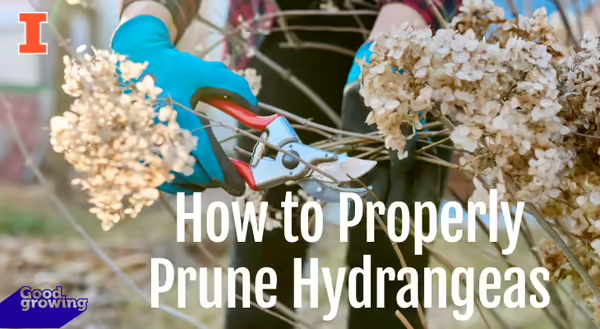
When pruning species that bloom on new wood such as panicle and smooth hydrangeas, you can remove as much as one-third to one-half of the total mass of the shrub. Hydrangeas are a popular blooming woody shrub that add attractive foliage and large, striking blossoms to landscapes. An important part to keeping those large blossoms is pruning. If hydrangeas don’t bloom for a season, it is likely due to not enough sun, an early frost, or incorrect pruning.
When to Prune Hydrangeas
To determine when to prune a hydrangea, it depends on whether it blooms on old wood (growth produced in the previous season) or new wood (growth produced in the current season). With hydrangeas, there are some species that bloom on old wood while others bloom on new wood which can complicate pruning.
When pruning hydrangeas that bloom on new growth, shrubs should be pruned in late winter or early spring just before new growth has started. Hydrangeas that produce blooms on old growth should be pruned as soon as the flowers have faded; this allows the shrub to develop wood that is “old” by the time flower buds emerge.
Download this guide on How to Prune Hydrangea.
How to Determine Hydrangea Species
There are six different species of hydrangea commonly in the landscape. If you don’t know the type of hydrangea you own, a simple observation of its leaves and flowering pattern can help you determine the type.
Blooms on New Wood
When pruning species that bloom on new wood such as panicle and smooth hydrangeas, you can remove as much as one-third to one-half of the total mass of the shrub.
- Panicle hydrangeas (Hydrangea paniculata) have large cone-shaped flower panicles that are white or green and gradually turn pink. Some favorite panicle hydrangeas include Limelight, Berry White, and Quick Fire. When pruning panicle hydrangeas, flowers develop on new wood, so pruning should be done in late winter or early spring.
- Smooth hydrangeas (H. arborescens) bloom on new wood and should be pruned in late winter to early spring. Their flowers are big and round in shades of pink or white; often referred to as snowballs. The most common variety of a smooth hydrangea is Annabelle.
Blooms on Old Wood
These four species that flower on old wood may not need pruning at all, except to keep their size or shape in check.
- Bigleaf hydrangeas (H. macrophylla) as the name implies have, large, long serrated leaves and large rounded flowers that bloom for extended periods throughout the summer. Soil pH affects the flower color of bigleaf hydrangeas; alkaline soils causes pink flowers, and acid soils cause blue flowers. This species blooms on old wood and should be pruned just after flowering. A well-known bigleaf hydrangea is Endless Summer.
- Oakleaf hydrangeas (H. quercifolia) can be identified by leaves that resemble those of an oak tree. They produce a cone-shaped flower early in the season; the bloom starts out cream or green in color and gradually becomes pink. Oakleaf hydrangeas flower on old wood and should be pruned immediately after flowering.
- Mountain hydrangeas (H. serrata) look like a bigleaf hydrangea but are more compact. The flowers of mountain hydrangeas also vary in color depending on the soil pH. Because these hydrangeas are smaller, they do not require as much pruning, but when necessary, it blooms on old wood and should be pruned after flowering.
- Climbing hydrangea (H. anomala subsp. petiolaris) is a climbing vine that can reach up to 40 feet high. White flowers form as flattened clusters up to 8 inches wide. When pruning this hydrangea, it should be done after the flowers have faded as flowers form on old wood.
MEET THE AUTHOR
Katie Parker is a Local Foods and Small Farms Educator with University of Illinois Extension, serving Adams, Brown, Hancock, Pike, and Schuyler counties. Katie provides programming with an emphasis on row crop production, soil fertility, composting, vegetable production, and ornamental horticulture.
Signup for our emails! Want to get notified when new Good Growing posts are available? SIGN ME UP